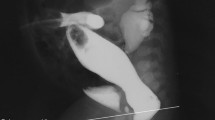Abstract
Background
For the last 20 years, laparoscopy management of anorectal malformations (ARM) has been challenged due to the development of postoperative urethral diverticulum or injury caused by the imprecise transection of rectourethral fistulae, particularly rectobulbar fistulae situated deep in the pelvis. We have developed a combined approach of enteroscopy and laparoscopy for intraluminal incision of a rectourethral fistula.
Methods
We retrospectively reviewed 47 ARM patients who underwent surgical corrections using the combined approach between January 2019 and June 2020. Early postoperative and subsequent follow-up results were evaluated.
Results
The median follow-up period was 12 months. The average age at surgery was 3.18 ± 0.64 months. The mean operative time of a single-incision laparoscopic-assisted anorectoplasty (SILAARP) was 1.19 ± 0.29 h. The time for intraluminal incision of the fistula was shortened from 14 to 2 min. No patients underwent a conversion. The average postoperative hospital stay, time to full feeds and placement of an anal tube were 10 days, 1 day, and 5 days, respectively. No urethral diverticulum, urinary injury, wound infection, rectal retraction, anal stenosis or rectal prolapse was encountered in the cohort.
Conclusions
The combined enteroscopy and laparoscopy approach offers precise management of rectourethral fistulae. It could effectively obviate urethral complications, eliminating the obstacles of laparoscopy application in the management of ARMs.


Similar content being viewed by others
References
Georgeson KE, Inge TH, Albanese CT (2000) Laparoscopic assisted anorectal pull-through for high imperforated anus—a new technique. J Pediatr Surg 35(6):927–931
Yamataka A, Lane G, Kato Y (2013) Laparoscopy-assisted surgery for male imperforate anus with rectourethral fistula. Pediatr Surg Int 29:1007–1011
Kudou S, Iwanaka T, Kawashima H, Uchida H, Nishi A, Yotsumoto K, Kaneko M (2005) Midterm follow-up study of high-type imperforate anus after laparoscopically assisted anorectoplasty. J Pediatr Surg 40(12):1923–1926
Tainaka T, Uchida H, Tanaka Y, Hinoki A, Shirota C, Sumida W, Yokota K, Makita S, Oshima K, Chiba K, Ishimaru T, Kawashima HT (2018) Long-term outcomes and complications after laparoscopic-assisted anorectoplasty vs. posterior sagittal anorectoplasty for high- and intermediate-type anorectal malformation. Pediatr Surg Int 34(10):1111–1115
Chung PHY, Wong CWY, Wong KKY, Tam PKH (2018) Assessing the long term manometric outcomes in patients with previous laparoscopic anorectoplasty (LARP) and posterior sagittal anorectoplasty (PSARP). J Pediatr Surg 53(10):1933–1936
Li L, Ren XH, Ming AX, Xu H, Sun R, Zhou Y, Liu XL, Sun HL, Li Q, Li X, Zhang Z, Cheng W, Diao M, Tam PKH (2020) Laparoscopic surgical technique to enhance the management of anorectal malformations: 330 cases’ experience in a single center. Pediatr Surg Int 36(3):279–287
Hong AR, Acuña MF, Peña A, Chaves L, Rodriguez G (2002) Urologic injuries associated with repair of anorectal malformations in male patients. J Pediatr Surg 37(3):339–344
Alam S, Lawal TA, Peña A, Sheldon C, Levitt MA (2011) Acquired posterior urethral diverticulum following surgery for anorectal malformations. J Pediatr Surg 46(6):1231–1235
Vinnicombe SJ, Good CD, Hall CM (1996) Posterior urethral diverticula: a complication of surgery for high anorectal malformations. Pediatr Radiol 26(2):120–126
Koga H, Okazaki T, Yamataka A, Kobayashi H, Yanai T, Lane GJ, Miyano T (2005) Posterior urethral diverticulum after laparoscopic-assisted repair of high-type anorectal malformation in a male patient: surgical treatment and prevention. Pediatr Surg Int 21(1):58–60
Rentea RM, Halleran DR, Vilanova-Sanchez A, Lane VA, Reck CA, Weaver L, Booth K, DaJusta D, Ching C, Fuchs ME, Jayanthi RR, Levitt MA, Wood RJ (2019) Diagnosis and management of a remnant of the original fistula (ROOF) in males following surgery for anorectal malformations. J Pediatr Surg 54(10):1988–1992
Diao M, Li L, Ye M, Cheng W (2014) Single-incision laparoscopic-assisted anorectoplasty using conventional instruments for children with anorectal malformations and rectourethral or rectovesical fistula. J Pediatr Surg 49(11):1689–1694
Stenström P, Anderberg M, Kockum CC, Arnbjornsson E (2013) Endoscopically placed rectourethral guidewire facilitates the reconstruction of anus in children with anorectal malformations: a case report. Eur J Pediatr Surg Rep 1(1):46–47
Yamataka A, Kato Y, Lee KD, Lane G, Kusafuka J, Okazaki T (2009) Endoscopy-assisted laparoscopic excision of rectourethral fistula in a male with imperforate anus. J Laparoendosc Adv Surg Tech A 19(Suppl 1):S241–S243
Koga H, Kato Y, Shimotakahara A, Miyano G, Lane GJ, Okazaki T, Yamataka A (2010) Intraoperative measurement of rectourethral fistula: prevention of incomplete excision in male patients with high-/intermediate-type imperforate anus. J Pediatr Surg 45(2):397–400
Diao M, Li L, Ye M, Guan KP, Wei YD, Cheng W (2016) Congenital Anomaly rectified at birth: one-stage single-incision laparoscopic-assisted anorectoplasty for newborns with anorectal malformations and recto-urethral fistula. Surg Endosc 30(11):5156–5164
Elhalaby E (2006) Primary repair of high and intermediate anorectal malformations in the neonates. Ann Pediatr Surg 2:117–122
Ming AX, Li L, Diao M, Wang HB, Liu Y, Ye M, Cheng W (2014) Long term outcomes of laparoscopic-assisted anorectoplasty: a comparison study with posterior sagittal anorectoplasty. J Pediatr Surg 49:560–563
Author information
Authors and Affiliations
Corresponding authors
Ethics declarations
Disclosures
Mei Diao, Long Li, Chi-Huan Kong, Qi Li, An-Xiao Ming, Zhen Zhang, and Wei Cheng declare no conflicts of interest or have any financial ties to disclose.
Additional information
Publisher's Note
Springer Nature remains neutral with regard to jurisdictional claims in published maps and institutional affiliations.
Supplementary Information
Below is the link to the electronic supplementary material.
Supplementary Information 1 (WMV 19679 kb)
Rights and permissions
About this article
Cite this article
Diao, M., Li, L., Kong, CH. et al. A novel combined enteroscopy and laparoscopy approach to prevent urethral complications in management of rectourethral fistula. Surg Endosc 35, 1921–1926 (2021). https://doi.org/10.1007/s00464-020-08268-y
Received:
Accepted:
Published:
Issue Date:
DOI: https://doi.org/10.1007/s00464-020-08268-y




